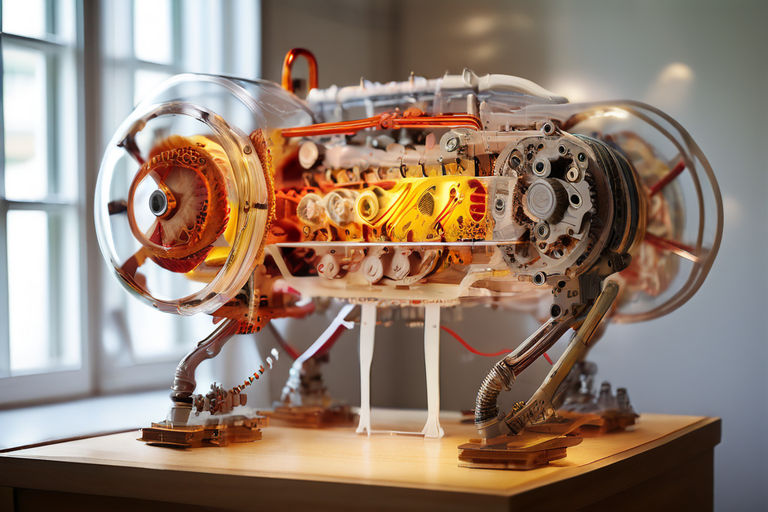Introduction to Speed and Kinetic Energy
- Introduction to Speed and Kinetic Energy
- Understanding Kinetic Energy
- The Role of Speed in Kinetic Energy
- Kinetic Energy in Motion
- Formula for Calculating Kinetic Energy
- Units of Measurement for Kinetic Energy
- Factors Affecting Kinetic Energy
- Examples of Kinetic Energy in Action
- Kinetic Energy and Potential Energy: A Dynamic Interplay
- Practical Applications of Kinetic Energy
- Safety Considerations with Kinetic Energy
- Importance of Kinetic Energy in Transportation
- Conclusion
In the vast realm of physics, few concepts are as fundamental and ubiquitous as speed and kinetic energy. These two interconnected principles form the cornerstone of our understanding of motion, permeating every aspect of our physical world. At their core, speed and kinetic energy encapsulate the essence of movement, shedding light on the dynamic nature of objects in motion.
Understanding Speed
Firstly, let’s unravel the essence of speed. Speed is a measure of how quickly an object traverses a certain distance over a specific period. It is a scalar quantity, meaning it is solely concerned with magnitude, devoid of any directional component. From the leisurely saunter of a pedestrian to the breakneck velocity of a spacecraft hurtling through the cosmos, speed encompasses a vast spectrum of velocities, each with its own unique implications and effects.
Exploring Kinetic Energy
Now, let’s turn our attention to kinetic energy, the driving force behind the motion. Kinetic energy is the embodiment of motion itself, the tangible expression of an object’s dynamic state. It arises from the collective movement of the constituent particles within an object, whether it be the atoms in a solid, the molecules in a liquid, or the celestial bodies in space. As objects move through space, they carry with them a reservoir of energy, ready to be harnessed and transformed into various forms of work and motion.
Unveiling the Relationship
At first glance, speed and kinetic energy may seem like distinct entities, each with its own unique characteristics and properties. However, upon closer examination, it becomes evident that they are intricately intertwined, with one invariably influencing the other. Indeed, the relationship between speed and kinetic energy is one of direct proportionality, wherein an increase in speed corresponds to a proportional increase in kinetic energy, and vice versa. This fundamental relationship forms the bedrock of numerous physical principles and phenomena, permeating disciplines ranging from mechanics to thermodynamics.
Significance and Applications
The significance of speed and kinetic energy extends far beyond the confines of theoretical physics, manifesting in myriad real-world applications and technologies. From the propulsion systems of spacecraft to the renewable energy sources powering our cities, the principles of speed and kinetic energy underpin countless innovations and advancements. Moreover, an understanding of these principles is essential for navigating the complexities of our modern world, enabling us to unravel the mysteries of the universe and harness its boundless potential.
In the pages that follow, we will embark on a journey through the intricate interplay between speed and kinetic energy, exploring their definitions, significance, and practical applications. From the bustling streets of urban metropolises to the far reaches of outer space, we will unravel the mysteries of motion and delve into the profound implications of these fundamental principles. So, join us as we embark on a quest to unravel the enigmatic nexus of speed and kinetic energy, and unlock the secrets of the universe.
Understanding Kinetic Energy
Kinetic energy stands as a cornerstone in the edifice of physics, embodying the essence of motion itself. At its essence, kinetic energy represents the dynamic potential inherent in every moving object. It is the energy that an object possesses by virtue of its motion, a testament to the ceaseless dance of particles and bodies in the universe.
The Essence of Motion
Motion, in its myriad forms, is a fundamental aspect of the universe, permeating every facet of existence. From the graceful orbit of celestial bodies to the frenetic bustle of particles at the quantum level, motion is an omnipresent force, shaping the very fabric of reality. Kinetic energy serves as the tangible manifestation of this motion, encapsulating the dynamic interplay of matter and energy.
The Kinetic Energy Formula
Central to our understanding of kinetic energy is the eponymous formula that governs its calculation. Expressed mathematically as 𝐾𝐸=12𝑚𝑣2KE=21mv2, where 𝐾𝐸KE represents kinetic energy, 𝑚m denotes the mass of the object, and 𝑣v signifies its velocity, this formula unveils the intricate relationship between mass, velocity, and energy. It elucidates how the kinetic energy of an object is contingent upon both its mass and the square of its velocity, underscoring the pivotal role these variables play in determining the energy of motion.
Implications of Mass and Velocity
The significance of mass and velocity in shaping kinetic energy cannot be overstated. Mass serves as the foundation upon which kinetic energy is built, dictating the magnitude of the energy reservoir within an object. Meanwhile, velocity, with its squared influence in the kinetic energy formula, amplifies the energy content of a moving object exponentially. Thus, even slight variations in velocity can engender profound alterations in kinetic energy, highlighting the intricate interplay between speed and energy.
Practical Applications
Beyond the realm of theoretical physics, kinetic energy finds myriad practical applications in everyday life and various fields of endeavor. From the propulsion systems of vehicles to the generation of renewable energy, the principles of kinetic energy underpin countless innovations and technologies. Moreover, an understanding of kinetic energy is essential for engineers, scientists, and innovators alike, enabling them to design efficient systems, optimize processes, and unlock new frontiers of discovery.
The Role of Speed in Kinetic Energy
Speed, as the quintessential measure of motion, holds sway over the kinetic energy of an object in ways both profound and far-reaching. At the heart of this relationship lies a fundamental truth: the velocity at which an object moves serves as a harbinger of its kinetic energy, shaping the very essence of its dynamic potential.
Direct Proportionality
Central to the interplay between speed and kinetic energy is the principle of direct proportionality. Put simply, as the speed of an object increases, so too does its kinetic energy. This direct correlation underscores the pivotal role that speed plays in determining the energy state of a moving object, with each incremental increase in velocity yielding a commensurate rise in kinetic energy.
Illustrating the Relationship
The symbiotic relationship between speed and kinetic energy finds eloquent expression in the kinetic energy formula. Here, velocity assumes a position of prominence, its squared presence serving as a poignant reminder of its profound influence on kinetic energy. As velocity increases, the kinetic energy of an object grows exponentially, propelled ever higher by the relentless march of motion.
Implications for Motion
The implications of the speed-kinetic energy relationship extend far beyond the realm of theoretical physics, permeating every facet of our physical world. From the thunderous roar of a speeding locomotive to the graceful dance of a soaring bird, the kinetic energy unleashed by motion shapes the very contours of our existence. Moreover, an understanding of this relationship is essential for engineers, scientists, and innovators seeking to harness the transformative power of kinetic energy in myriad applications.
Harnessing the Power
In the annals of human endeavor, the mastery of speed and kinetic energy has fueled countless innovations and advancements. From the invention of the steam engine to the advent of high-speed rail, humanity has harnessed the latent energy of motion to propel itself ever forward. Today, as we stand on the precipice of a new era of exploration and discovery, the principles of speed and kinetic energy serve as guiding beacons, illuminating the path to a future where the boundless potential of motion knows no bounds.
Kinetic Energy in Motion
As objects traverse through space, they carry with them a silent yet potent force: kinetic energy. This energy, borne of motion itself, infuses every particle and body with a vitality that permeates the very fabric of existence. From the mundane to the magnificent, the presence of kinetic energy is ubiquitous, manifesting in a myriad of scenarios that underscore its profound influence on the world around us.
Manifestations of Kinetic Energy
The presence of kinetic energy reveals itself in a myriad of manifestations, each a testament to the dynamic potential inherent in motion. Picture, if you will, the thunderous roar of a speeding car hurtling down a bustling highway, its kinetic energy propelling it forward with unbridled force. Or consider the graceful revolutions of a spinning turbine within a power plant, harnessing the kinetic energy of moving air or water to generate electricity. In each scenario, the latent energy of motion is brought to life, driving the machinery of the modern world with an inexorable vigor.
Velocity as the Catalyst
At the heart of the kinetic energy phenomenon lies a simple yet profound truth: velocity is the catalyst that unleashes its transformative power. Indeed, the kinetic energy of an object is inexorably linked to its velocity, with increases in speed leading to corresponding escalations in energy. As objects accelerate through space, their kinetic energy burgeons, propelled ever higher by the relentless march of motion. This direct relationship between velocity and kinetic energy serves as a guiding principle, illuminating the path to a deeper understanding of the dynamic interplay between speed and energy.
Implications for Motion
The implications of kinetic energy in motion extend far beyond the confines of theoretical physics, permeating every facet of our physical world. From the efficient operation of machinery to the exhilarating rush of a roller coaster ride, the transformative power of kinetic energy shapes the very contours of our existence. Moreover, an understanding of this phenomenon is indispensable for engineers, scientists, and innovators seeking to harness its potential in myriad applications, from renewable energy generation to transportation systems.
Embracing the Potential
In the grand tapestry of human achievement, the mastery of kinetic energy stands as a testament to our ingenuity and resourcefulness. From the humble beginnings of the water wheel to the cutting-edge technologies of the modern era, humanity has continually sought to harness the latent energy of motion for the betterment of society. Today, as we stand on the cusp of a new age of exploration and discovery, the boundless potential of kinetic energy beckons us forward, inspiring us to unlock new frontiers of innovation and progress.
Formula for Calculating Kinetic Energy
At the heart of the concept of kinetic energy lies a simple yet elegant formula that encapsulates its essence. Expressed mathematically as 𝐾𝐸=12𝑚𝑣2KE=21mv2, where 𝐾𝐸KE represents kinetic energy, 𝑚m denotes the mass of the object, and 𝑣v signifies its velocity, this formula serves as a cornerstone in our understanding of the dynamic interplay between motion and energy.
Unveiling the Equation
The kinetic energy formula unveils the intricate relationship between mass, velocity, and energy, laying bare the underlying mechanisms that govern the motion of objects in our universe. At its core, the formula reveals that the kinetic energy of an object is directly proportional to the square of its velocity, with mass serving as a foundational determinant of energy content.
Significance of Velocity Squared
Central to the kinetic energy formula is the squared term that encapsulates the velocity of the object. This exponentiation underscores the profound impact that velocity exerts on kinetic energy, magnifying its influence exponentially with each incremental increase in speed. Indeed, as velocity surges, so too does the kinetic energy of the object, propelled ever higher by the relentless march of motion.
Implications for Energy Transfer
The kinetic energy formula holds profound implications for the transfer and transformation of energy in the physical world. As objects accelerate through space, their kinetic energy burgeons, manifesting in a multitude of forms, from the thunderous roar of a moving vehicle to the kinetic thrust of a projectile in flight. Moreover, an understanding of this formula is indispensable for engineers, scientists, and innovators seeking to harness its potential in myriad applications, from transportation systems to renewable energy generation.

Harnessing the Power of Motion
In the annals of human achievement, the mastery of kinetic energy stands as a testament to our ingenuity and resourcefulness. From the invention of the steam engine to the advent of high-speed rail, humanity has continually sought to harness the latent energy of motion for the betterment of society. Today, as we stand on the cusp of a new age of exploration and discovery, the boundless potential of kinetic energy beckons us forward, inspiring us to unlock new frontiers of innovation and progress.
Units of Measurement for Kinetic Energy
In the realm of physics, the measurement of kinetic energy is governed by a set of standardized units that facilitate accurate calculations and comparisons. At the forefront of these units stands the joule (J), the quintessential measure of energy in the International System of Units (SI). As the cornerstone of energy measurement, the joule serves as the primary unit for expressing kinetic energy across various contexts and applications.
The Joule: Standard Unit of Energy
The joule (J) represents the fundamental unit of energy in the SI system, encompassing a broad spectrum of energy forms, including kinetic energy. Defined as the work done or energy transferred when a force of one newton is applied over a distance of one meter, the joule provides a standardized measure for quantifying the dynamic potential inherent in moving objects.
Supplementary Units: Kilojoules and Electronvolts
While the joule serves as the standard unit for measuring kinetic energy, supplementary units may also be employed to accommodate specific contexts and scales. One such unit is the kilojoule (kJ), equivalent to one thousand joules, often utilized to express kinetic energy on a larger scale or in practical applications where precision is paramount.
Alternatively, in the realm of particle physics and quantum mechanics, the electronvolt (eV) emerges as a convenient unit for quantifying energy on a subatomic level. Defined as the amount of kinetic energy gained or lost by an electron when accelerated through an electric potential difference of one volt, the electronvolt provides a nuanced perspective on energy transfer and transformation in the microscopic domain.
Ensuring Accuracy and Precision
In expressing kinetic energy, it is imperative to select the appropriate unit of measurement to ensure accuracy and precision in calculations and comparisons. Whether employing joules, kilojoules, or electronvolts, the chosen unit must align with the context and scale of the phenomenon under investigation, enabling researchers, engineers, and scientists to derive meaningful insights and conclusions from their analyses.
Factors Affecting Kinetic Energy
In the dynamic interplay between motion and energy, several key factors exert a profound influence on the kinetic energy of an object. Chief among these factors are mass and velocity, whose interplay shapes the energy state of moving objects and underpins the fundamental principles governing kinetic energy.
Mass: The Foundation of Energy
At the heart of the kinetic energy equation lies the mass of the object in motion. Mass serves as the foundational determinant of kinetic energy, with larger masses possessing a greater reservoir of energy at the same velocity. This direct relationship underscores the pivotal role that mass plays in shaping the energy content of moving objects, with heavier masses endowed with a greater capacity to do work and impart force upon collision.
Velocity: The Catalyst for Energy Transfer
Velocity stands as the primary driver of kinetic energy, serving as the catalyst for energy transfer and transformation in the physical world. Even small changes in speed can lead to significant alterations in kinetic energy, with increases in velocity resulting in proportional escalations in energy. This direct relationship between velocity and kinetic energy underscores the profound impact that speed exerts on the dynamic potential of moving objects, with higher velocities yielding greater energy outputs and vice versa.
Interplay Between Mass and Velocity
The relationship between mass and velocity serves as a cornerstone in our understanding of kinetic energy, with each factor influencing the other in intricate ways. While mass dictates the magnitude of energy stored within an object, velocity amplifies this energy exponentially, magnifying its impact on the surrounding environment. Thus, even slight alterations in either mass or velocity can engender profound changes in kinetic energy, underscoring the delicate balance between these two fundamental determinants.
Implications for Energy Transfer
The implications of these factors extend far beyond the confines of theoretical physics, permeating every facet of our physical world. From the propulsion systems of vehicles to the dynamics of collisions in sports, the interplay between mass and velocity shapes the very contours of our existence. Moreover, an understanding of these factors is indispensable for engineers, scientists, and innovators seeking to harness the transformative power of kinetic energy in myriad applications, from transportation systems to renewable energy generation.
Examples of Kinetic Energy in Action
The concept of kinetic energy finds numerous applications in everyday life and various fields, including physics, engineering, and sports. For instance, a moving car possesses kinetic energy, which is converted into other forms of energy when it comes to a stop. In sports such as baseball or tennis, the kinetic energy of a ball determines its speed and impact upon collision.
Kinetic Energy and Potential Energy: A Dynamic Interplay
In the intricate tapestry of mechanical energy, two fundamental forms stand at the forefront: kinetic energy and potential energy. These intertwined entities, each with its unique characteristics and manifestations, embody the essence of motion and position, serving as the building blocks of energy transfer and transformation in the physical world.
Potential Energy: Energy of Position
At its core, potential energy is the latent energy stored within an object by virtue of its position or state. Whether it be the gravitational potential energy of an object perched atop a hill or the elastic potential energy of a stretched spring, potential energy serves as a testament to the inherent vitality imbued within objects by their spatial arrangement. This stored energy awaits release, poised to manifest itself in the form of kinetic energy when conditions permit.
Kinetic Energy: Energy of Motion
In contrast, kinetic energy represents the vibrant energy of motion, encapsulating the dynamic potential inherent in moving objects. As objects traverse through space, they carry with them a reservoir of kinetic energy derived from their velocity. Whether it be the thunderous roar of a speeding car or the graceful glide of a soaring bird, kinetic energy permeates every facet of motion, driving the machinery of the modern world with unbridled force.
The Interplay: Transformation and Conservation
The relationship between kinetic energy and potential energy is one of dynamic interplay and transformation. As an object descends from a higher elevation to a lower one, its gravitational potential energy is converted into kinetic energy, propelling it forward with increasing velocity. Conversely, when an object ascends against gravity, kinetic energy is transformed back into potential energy, manifesting in the object’s elevated position. This elegant exchange illustrates the principle of conservation of energy, wherein energy is neither created nor destroyed but merely changes form, traversing seamlessly between the realms of potential and kinetic energy.
Implications for Understanding and Innovation
The understanding of the relationship between kinetic energy and potential energy holds profound implications for myriad fields of study and endeavor. From the design of roller coasters and pendulum clocks to the optimization of renewable energy systems, this knowledge enables engineers, scientists, and innovators to harness the transformative power of mechanical energy in innovative and impactful ways. Moreover, it underscores the interconnectedness of all phenomena in the physical world, illuminating the intricate web of relationships that govern motion and energy transfer on both macroscopic and microscopic scales.
Practical Applications of Kinetic Energy
The harnessing and utilization of kinetic energy have ushered in a new era of innovation and sustainability across various industries and technologies. From renewable energy sources to transportation systems, kinetic energy plays a pivotal role in driving progress and shaping the future of our world.
Renewable Energy Generation: Wind and Water Power
One of the most notable applications of kinetic energy lies in the realm of renewable energy generation. Wind turbines and hydroelectric dams harness the kinetic energy of moving air and water, respectively, to generate electricity on a massive scale. As the wind sweeps across the landscape or water flows through turbines, kinetic energy is converted into electrical energy through the rotation of turbine blades or the movement of water turbines. This sustainable approach to energy production not only reduces reliance on fossil fuels but also mitigates environmental impact, paving the way for a greener, more sustainable future.
Transportation Systems: High-Speed Trains and Electric Vehicles
Kinetic energy-based transportation systems represent another prominent application of this versatile energy form. High-speed trains, propelled by electric motors, harness the kinetic energy of motion to transport passengers and goods across vast distances with remarkable efficiency. As these trains accelerate along their tracks, kinetic energy is stored within their moving mass, enabling them to reach speeds that rival traditional modes of transportation while minimizing environmental impact.
Similarly, electric vehicles (EVs) leverage the principles of kinetic energy to propel themselves forward, utilizing electric motors powered by onboard batteries. As the vehicle accelerates, kinetic energy is derived from the motion of its wheels, enabling it to traverse city streets and highways with zero emissions and reduced dependence on fossil fuels. This paradigm shift in transportation technology heralds a new era of mobility, characterized by sustainability, efficiency, and innovation.
Sports and Recreation: Kinetic Energy in Action
Beyond the realm of industry and technology, kinetic energy finds expression in the realm of sports and recreation. From the propulsion of bicycles and skateboards to the exhilarating rush of downhill skiing, kinetic energy imbues recreational activities with a sense of dynamism and vitality. Whether it be the graceful glide of a surfer riding a wave or the explosive power of a basketball player leaping for a dunk, the kinetic energy of motion adds an extra dimension of excitement and adventure to our leisure pursuits.
Safety Considerations with Kinetic Energy
While kinetic energy presents a plethora of benefits and applications, it also carries inherent risks, especially in environments characterized by high speeds or energy levels. To ensure the safe handling and utilization of kinetic energy, stringent safety measures and protocols must be implemented across various industries and applications.
Risk Assessment and Hazard Identification
At the outset, it is imperative to conduct comprehensive risk assessments and hazard identifications to identify potential sources of danger associated with kinetic energy. Whether it be in manufacturing facilities, transportation systems, or recreational activities, a thorough understanding of the risks inherent in working with kinetic energy is essential for developing effective safety strategies and protocols.
Training and Education
Proper training and education are paramount to ensuring the safe handling and operation of equipment and machinery powered by kinetic energy. Workers and operators must receive comprehensive training on equipment operation, safety procedures, and emergency protocols to mitigate the risk of accidents and injuries. Additionally, ongoing education and refresher courses are crucial to keeping workers abreast of the latest safety practices and regulations.
Equipment Maintenance and Inspection
Regular maintenance and inspection of equipment are essential to prevent mechanical failures and ensure the safe operation of machinery powered by kinetic energy. Routine checks of components such as bearings, gears, and braking systems can help identify potential issues before they escalate into serious safety hazards. Furthermore, adherence to manufacturer-recommended maintenance schedules and protocols is paramount to preserving the integrity and reliability of equipment over time.
Personal Protective Equipment (PPE)
The use of appropriate personal protective equipment (PPE) is essential to safeguarding workers from the potential hazards associated with kinetic energy. Depending on the nature of the work environment and the level of risk involved, PPE such as helmets, safety goggles, gloves, and high-visibility clothing may be required to protect against impact, flying debris, and other occupational hazards.
Adherence to Safety Protocols
Strict adherence to safety protocols and procedures is non-negotiable when working with kinetic energy. Clear signage, designated work zones, and lockout/tagout procedures can help prevent accidents and ensure the safe operation of machinery and equipment. Additionally, the establishment of safety committees and regular safety audits can help foster a culture of safety awareness and accountability within organizations.
Importance of Kinetic Energy in Transportation
Transportation systems serve as the lifeblood of modern society, enabling the movement of goods and people across vast distances with unprecedented speed and efficiency. At the heart of these systems lies the transformative power of kinetic energy, which propels vehicles forward and drives the wheels of progress in the realm of transportation.
Propelling Vehicles Forward
Kinetic energy serves as the driving force behind the motion of vehicles in transportation systems worldwide. Whether it be the roar of an internal combustion engine propelling an automobile down a bustling highway or the silent glide of an electric motor powering a train along its tracks, kinetic energy imbues transportation vehicles with the dynamic potential needed to traverse vast distances with remarkable speed and efficiency.
Enabling Efficient Operation
The efficient operation of transportation systems relies heavily on the judicious harnessing and utilization of kinetic energy. From the optimization of engine performance in automobiles to the precise control of propulsion systems in aircraft, kinetic energy plays a vital role in maximizing the efficiency and effectiveness of transportation technologies. By harnessing the kinetic energy derived from the motion of vehicles, transportation systems can achieve higher levels of energy efficiency and reduce environmental impact, paving the way for a more sustainable and eco-friendly future.
Driving Technological Advancements
As advancements continue in transportation technology, the importance of kinetic energy in shaping the future of transportation becomes increasingly evident. Electric vehicles (EVs), powered by electric motors fueled by onboard batteries, exemplify the transformative potential of kinetic energy in transportation. By harnessing the kinetic energy derived from the motion of their wheels, EVs offer a cleaner, more sustainable alternative to traditional combustion engine vehicles, reducing emissions and dependence on fossil fuels while driving technological innovation and progress in the automotive industry.
Embracing Future Innovations
Moreover, emerging transportation technologies such as hyperloop systems and autonomous vehicles promise to revolutionize the way we think about transportation, further highlighting the importance of kinetic energy in shaping the future of mobility. Hyperloop systems, propelled by magnetic levitation and vacuum tubes, harness the power of kinetic energy to propel passengers and cargo at incredible speeds, offering a glimpse into a future where travel is faster, safer, and more efficient than ever before. Similarly, autonomous vehicles, equipped with advanced sensors and artificial intelligence, leverage kinetic energy to navigate roads and highways with precision and accuracy, ushering in a new era of transportation innovation and autonomy.
Conclusion
In conclusion, the relationship between speed and kinetic energy is a fundamental aspect of physics with wide-ranging implications. By understanding the interplay between speed, mass, and kinetic energy, we gain insights into the behavior of objects in motion and can harness this knowledge for various practical applications. Whether in renewable energy generation, transportation systems, or everyday activities, the principles of speed and kinetic energy continue to shape our world.



















No Comments
Leave a comment Cancel